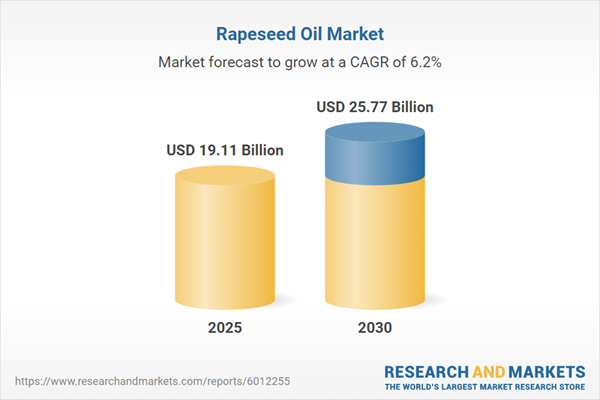Speak directly to the analyst to clarify any post sales queries you may have.
The global rapeseed oil market continues to evolve, shaped by shifting consumer preferences, regulatory demands, and increased focus on sustainability across supply chains and applications.
Market Snapshot: Rapeseed Oil Market Growth and Trends
The rapeseed oil market grew from USD 18.01 billion in 2024 to USD 19.11 billion in 2025, maintaining robust momentum with a projected CAGR of 6.15% to reach USD 25.77 billion by 2030. This growth reflects surging demand for healthier edible oils, evolving regulatory frameworks aimed at renewable energy, and rapid advancements in processing technologies. As rapeseed oil cements its value as a multipurpose input, producers, distributors, and end users must navigate a landscape characterized by both opportunity and complexity.
Scope & Segmentation of the Rapeseed Oil Market
- Types: Processed and Virgin varieties cater to distinct needs, from large-scale industrial output to premium culinary applications.
- Processing Methods: Markets utilize Cold Pressing, Expeller Pressing, and Solvent Extraction, prioritizing nutritional retention, yield, and cost-efficiency.
- Grades: Edible and Industrial grades support diversified use in human consumption, biofuels, cosmetics, and pharmaceuticals.
- Packaging Formats: Offerings include glass bottles, PET bottles, cans, drums, and pouches to address retail, B2B, and bulk requirements.
- Applications: Biofuel production, cosmetics, foodservice, baking, grilling, frying, salad dressings, sauces, marinades, and pharmaceuticals represent key end uses.
- Distribution Channels: Offline sales via specialty stores, supermarkets, hypermarkets, and online through brand-owned platforms and eCommerce providers.
- Regions Covered: The analysis spans the Americas (United States, Canada, Mexico, Brazil, Argentina, Chile, Colombia, Peru), Europe, Middle East & Africa (United Kingdom, Germany, France, Russia, Italy, Spain, Netherlands, Sweden, Poland, Switzerland, United Arab Emirates, Saudi Arabia, Qatar, Turkey, Israel, South Africa, Nigeria, Egypt, Kenya), and Asia-Pacific (China, India, Japan, Australia, South Korea, Indonesia, Thailand, Malaysia, Singapore, Taiwan).
- Major Companies Reviewed: Includes a comprehensive set of industry leaders and innovators such as American Vegetable Oils, Inc., Archer Daniels Midland Company, Bunge Limited, Cargill Incorporated, COFCO Group, and Wilmar International Limited, among others.
Key Takeaways for Senior Decision-Makers
- Sustainability credentials increasingly shape procurement and investment choices as end users demand traceable and environmentally responsible rapeseed oil.
- Technological innovation in processing and digital monitoring drives supply chain optimization and product quality advancements.
- Health-conscious consumers drive segment expansion for virgin and cold-pressed rapeseed oils in both culinary and cosmetic markets.
- Packaging evolution and digital distribution enable brands to tailor offerings for both bulk buyers and omnichannel consumers, strengthening global reach.
- Strategic partnerships and forward integration within supply chains help leading companies mitigate risk and unlock operational efficiencies.
Tariff Impact: United States 2025 Import Tariffs
Forthcoming U.S. tariffs on rapeseed oil imports prompt exporters to reconsider distribution strategies while North American buyers seek alternatives to manage rising costs. Producers are rebalancing their sourcing and procurement models to maintain competitiveness. These shifts accelerate the push toward value-added products, regional processing investment, and supplier diversification across Europe and Asia-Pacific, fostering resilience and adaptability throughout the value chain.
Methodology & Data Sources
This report follows a rigorous methodology combining in-depth secondary research, primary expert interviews, and cross-referencing of industry and regulatory data. Desk research draws from academic literature and white papers, while targeted conversations with agronomists, engineers, and strategists validate market trends and operational challenges.
Why This Report Matters: Strategic Value for Decision-Makers
- Enables proactive alignment with sustainability mandates, improving regulatory compliance and bolstering brand trust.
- Supports tactical planning in procurement, product development, and market entry for diversified regional strategies.
- Provides clarity on competitive positioning by benchmarking leading players and highlighting innovation best practices.
Conclusion
The rapeseed oil market offers dynamic opportunities as sustainability, innovation, and trade policies reshape industry priorities. With actionable insights and data-backed analysis, stakeholders are equipped to adapt strategy, pursue new growth, and reinforce competitive advantage in an evolving global ecosystem.
Additional Product Information:
- Purchase of this report includes 1 year online access with quarterly updates.
- This report can be updated on request. Please contact our Customer Experience team using the Ask a Question widget on our website.
Table of Contents
3. Executive Summary
4. Market Overview
7. Cumulative Impact of Artificial Intelligence 2025
Companies Mentioned
The companies profiled in this Rapeseed Oil market report include:- American Vegetable Oils, Inc.
- Archer Daniels Midland Company
- Ashoka Oil Industries
- Bunge Limited
- Cargill Incorporated
- Champlor by Valtris Specialty Chemicals Group
- ChemQuest International, Inc.
- CHS Inc.
- COFCO Group
- Cotswold Gold
- CP&Co
- Cullise Ltd.
- Farrington Oils Limited
- FUJI OIL CO., LTD.
- GrainCorp Limited
- Highwood Crossing Foods Ltd.
- Hillfarm Oils Ltd.
- J-OIL MILLS , INC.
- Jivo Wellness Pvt. Ltd.
- Kumar Metal Industries Pvt Ltd
- Louis Dreyfus Company B.V.
- Mackintosh of Glendaveny
- Midlands Holdings
- Ngo Chew Hong Edible Oil Pte Ltd by Mewah International Inc
- O. & L. SELS GmbH & Co. KG
- Oiltrade B.V.
- Richardson International Limited
- Sunora Foods Inc.
- Supernature Oils Limited
- Vigon International, LLC
- Wilmar International Limited
Table Information
| Report Attribute | Details |
|---|---|
| No. of Pages | 189 |
| Published | November 2025 |
| Forecast Period | 2025 - 2030 |
| Estimated Market Value ( USD | $ 19.11 Billion |
| Forecasted Market Value ( USD | $ 25.77 Billion |
| Compound Annual Growth Rate | 6.1% |
| Regions Covered | Global |
| No. of Companies Mentioned | 32 |









